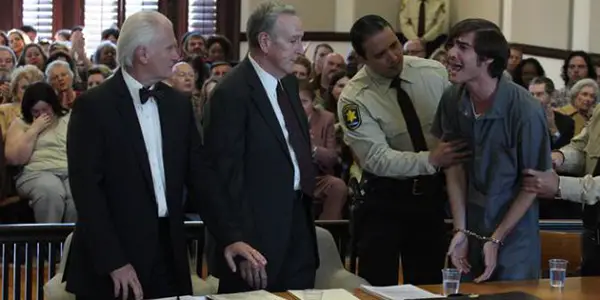The death penalty is a scary subject, fraught with horror even when the condemned is guilty. So it’s surprising, then, that none of the most famous films about the death penalty, like 10 Rillington Place, The Green Mile, Dead Man Walking, Pierrepoint, or A Short Film About Killing, are actually horror movies.
Sure, they contain horrific moments (the botched execution scene in The Green Mile seared itself onto my brain, after a viewing at far too young an age). But death penalty films, certainly the most well-known ones, don’t tend to turn the subject into full on, blood-soaked, scare-filled horror films.
Johnny Frank Garrett’s Last Word aims to rectify that situation. ‘Aims to’, here being the operative phrase.
The Plot
We begin in court, with District Attorney Danny Hill (Sean Patrick Flannery) making one last summary of the evidence stacked up against Johnny Frank Garrett (Devin Bonnée), who has been charged with the rape and murder of an elderly nun. His fingerprints were all over the murder scene, he was spotted in the area, acting strangely whilst strung out on LSD, and a psychic (Sue Rock) claimed to have been told his identity in a dream. It’s all circumstantial, but it’s enough for the jury, with Adam (Mike Doyle), the one hold-out, soon being convinced to vote guilty.
Ten years later, just prior to his execution, Johnny Frank Garrett writes a long, angry letter, maintaining his innocence and vowing revenge on everyone even tangentially related to his unjust execution. And sure enough, soon people connected to the case begin to die in various mysterious circumstances. Adam, the skeptical juror, sets out to investigate.
Painted In Broad Strokes
The first thing you may notice about Johnny Frank Garrett’s Last Word is the hyper-Texan religiosity. It’s ladled on so thick that it’s basically parody. In the crowd outside the courtroom in the film’s opening scenes, everyone’s wearing a cowboy hat, carrying a sign that says some variation on ‘An Eye for an Eye’, or both. As Adam first expresses his doubts in the juror’s meeting, the first response he gets is “Would you like us to pray again?” A few minutes later, we are introduced to Adam’s family at his son Sam’s (Dodge Prince) birthday party. When he can’t blow out all the candles in one go, Sam asks fearfully, “Will God still grant my wish?”

Though it’s undoubtedly a fact that Texas has a higher proportion of the religious right than your average locale, none of it rings true here. I wasn’t at all surprised to learn that the film’s director Simon Rumley is in fact, British; it all seems very much like a non-native’s idea of a place, based solely on what they’ve learned in other movies and TV shows.
This broad strokes painting that Rumley and screenwriter Ben Ketai engage in extends through every character we see, with the exception of Adam and his wife Laura (Erin Cummings). Cummings and Doyle give committed, if occasionally beige performances; their reactions to all the madness spinning around them actually seems to have some basis in truth.
Though Doyle isn’t the most exciting leading man, at least he’s convincing. This is a lot more than you can say for Sean Patrick Flannery‘s cookie-cutter ‘Evil DA’ or Sue Rock‘s ‘Crazy Psychic’; gossamer-thin characters we’ve seen so often before, the actors can’t do anything to make them engaging.
Is It Scary Though?
In a word: no.
There is one death scene that is hard to watch. Being the one successful, seemingly unique bit of horror in the whole movie, I don’t want to ruin it for you. But let’s just say, you know that corny joke where you stick chopsticks up your nose and pretend to be a walrus? Well after you see this scene, you won’t be doing that again.
Other than that moment, though, every attempt to scare falls flat. Rumley has his methods and he runs and runs with them; the film is endless manic cutting and extreme closeups in an attempt to whip you up into feeling something akin to fear. The amount of bloody vomit that these characters spew could drown someone. And that iconic ‘All Work And No Play’ scene in The Shining clearly had a huge effect on the director, because there’s nary a wall in this film that doesn’t end up covered in crazed, repetitive writing.
In Conclusion
What is particularly galling about the multi-fronted failure of Johnny Frank Garrett’s Last Word is that it’s based on a true story. Johnny Frank Garrett was a real man who was actually executed for the rape and murder of a nun; his wrongful conviction is explored in Jesse Quackenbush‘s documentary The Last Word.
It’s a fascinating story, both in terms of the wrongful conviction and the string of people connected to the case who died soon after. In the hands of a better director, and with a decent screenplay, this could have been an interesting film. But Rumley just retreads the same tired old beats that you’ve seen in every other below-average horror film of the last thirty years. It’s a waste of material that other filmmakers would kill for.
Have you seen Johnny Frank Garrett’s Last Word? What did you think?
Johnny Frank Garrett’s Last Word sees release in the US on March 13, 2016.
Does content like this matter to you?
Become a Member and support film journalism. Unlock access to all of Film Inquiry`s great articles. Join a community of like-minded readers who are passionate about cinema - get access to our private members Network, give back to independent filmmakers, and more.